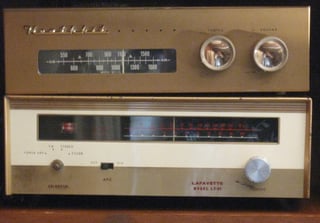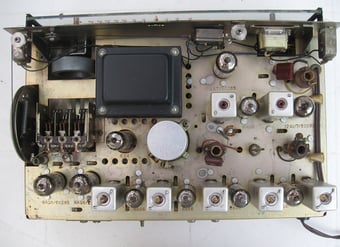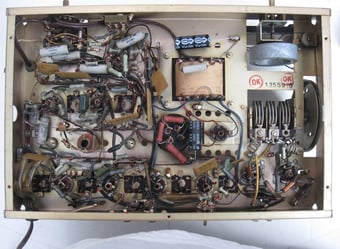Vintage Audio: Lafayette LT-81 FM Stereo Tuner | Telos Alliance
By The Telos Alliance Team on Aug 22, 2016 10:53:00 AM
 Vintage Audio: Lafayette LT-81 FM Stereo Tuner
Vintage Audio: Lafayette LT-81 FM Stereo Tuner
The 1960s were a transitional time for consumer electronics. The market for quality equipment was dominated mostly by American and German companies. By the mid-1970s, Sony and Panasonic were the names to watch. It didn't happen overnight. The earliest Japanese imports were laughable examples of shoddy workmanship and design. But they quickly learned from their mistakes, and began to roll out quality products rather quickly. In the end, American companies either went out of business or changed directions and went into things like government contracts.
This installment of Found in the Attic looks at an import from the mid-1960s, the Lafayette Radio Electronics LT-81 FM stereo tuner. It is typical of mid-1960s Japanese electronics. Not quite the same quality as mid 1970s gear, but a definite step up from the marginal late 50s-early 60s devices. It shows the influence of European electronics manufacturing. All the hardware is metric. Tube designations are stamped on the chassis in both European and American designations, i.e. 6AQ8/ECC85. All hardware and IF tweaks are sealed with white enamel, a technique probably copied from the Germans. Several blue ink 'OK' stamps inside the chassis indicate that it received the blessing of various quality control inspectors along the way.
The LT-81 has 11 tubes, and is conventional in design. A later variant, the LT-81C replaced the tuning meter with a magic eye tube. Although this is a mid-priced design, the finish and mechanical construction are impressive. The paint finish on the enameled cover and front panel is flawless. It was built before the days when manufacturers began substituting plastic parts for metal at every opportunity.
This LT-81 works, although not very well. All of the components are original, making them about 50 years old. In addition to the mandatory replacement of electrolytics, a rebuild would entail doing the same for the gray plastic tubular caps which are really paper, and are notorious in older Japanese equipment. Service information for this, and lots of Lafayette gear, can be difficult to track down.
Along with Radio Shack, Lafayette Radio Electronics (LRE) started out in the 1920s as a mail-order catalog store. They made electronic components available to hobbyists and ham radio operators in rural locations where those parts would otherwise be unavailable.
Over the next 30 years, electronics parts stores grew in number, gradually expanding from large cites into smaller towns. The movement got a big boost at the end of WWII, when tons of surplus components were sold by the government, giving rise to the popular parts 'grab bags', i.e. 100 assorted capacitors for 59 cents. Most of those stores sold a mix of electronics components and hi-fi gear or consumer electronics. During these years, many of the mom and pop electronics shops had become Lafayette radio 'associate stores'.
In the 1960s, LRE jumped into the market with their own storefronts, kicking out the associate stores along the way. These new company-owned outlets had a two-pronged marketing strategy. They stocked a limited number of components and electronics devices, but could quickly get anything in the massive 400-page LRE catalog. Within its pages were musical instruments, kits, cameras, parts, tubes and a wide range of consumer electronics devices. Typically an order placed at the store would arrive in a couple days.
The second part of the strategy was creating optimized listening environments in the stores to promote the sales of hi-fi gear. These sound rooms had all the gear wired through switch panels, so it was easy to do A-B-C comparisons of different tuners, amps and speakers. LRE was heavily involved in the promotion of quad sound in the late 60s and 70s, selling both LRE and competing brands of four-channel gear. Quad eventually tanked, and Lafayette took a loss while liquidating its four-channel inventory.
To arrive at a favorable price point for its merchandise, most of Lafayette's hi-fi, consumer and short-wave gear was made in Japan. Even the few items that were made in the USA had Japanese components.
LRE also rode the wave of ever-changing consumer electronics trends of the 60s and 70s, selling CB radios, 8-tracks, automotive electronics, cassettes, TV and FM antennas, along with the necessary accessories and parts to install and maintain all of the above.
Back then, Lafayette and Radio Shack were arch rivals. But even at its peak, LRE was always a distant second to Radio Shack in the number of stores it had. The beginning of the end for LRE came in 1963, when the FC C expanded the citizens band spectrum from 23 to 40 channels. The company was a big player in the CB market, and had made a commitment to purchase thousands of 23 channel transceivers right before the FCC's announcement. Lafayette took a bath when they liquidated the inventory, finally selling them for less than $40. In the end, they lost millions with this move.
C expanded the citizens band spectrum from 23 to 40 channels. The company was a big player in the CB market, and had made a commitment to purchase thousands of 23 channel transceivers right before the FCC's announcement. Lafayette took a bath when they liquidated the inventory, finally selling them for less than $40. In the end, they lost millions with this move.
Reeling from this financial hit, along with competitive pricing strategies that became popular in the late ‘70s, LRE began closing the less profitable stores at the same time that Radio Shack was expanding. Lafayette filed for Chapter 11 in January of 1980. Finally, only a handful of stores remained in New York, New Jersey and Massachusetts. By the end of 1981, they were all gone.
Our LT-81 was found in 1998, on the Penn campus in a dumpster near a dormitory that was being renovated. Perhaps it was part of a public address system, although no other electronic devices were found. It was missing a knob and some of the hardware. At the time, it was given a cosmetic clean up, and packed away for the next 18 years. It is pictured on display with a Heath BC-1A AM tuner, the subject of an earlier Found in the Attic. They depict a duo that might have been used for radio listening by a hi-fi enthusiast in the mid-1960s.
Telos Alliance has led the audio industry’s innovation in Broadcast Audio, Digital Mixing & Mastering, Audio Processors & Compression, Broadcast Mixing Consoles, Audio Interfaces, AoIP & VoIP for over three decades. The Telos Alliance family of products include Telos® Systems, Omnia® Audio, Axia® Audio, Linear Acoustic®, 25-Seven® Systems, Minnetonka™ Audio and Jünger Audio. Covering all ranges of Audio Applications for Radio & Television from Telos Infinity IP Intercom Systems, Jünger Audio AIXpressor Audio Processor, Omnia 11 Radio Processors, Axia Networked Quasar Broadcast Mixing Consoles and Linear Acoustic AMS Audio Quality Loudness Monitoring and 25-Seven TVC-15 Watermark Analyzer & Monitor. Telos Alliance offers audio solutions for any and every Radio, Television, Live Events, Podcast & Live Streaming Studio With Telos Alliance “Broadcast Without Limits.”
More Topics: Vintage Electronics
Recent Posts
Subscribe
If you love broadcast audio, you'll love Telos Alliance's newsletter. Get it delivered to your inbox by subscribing below!